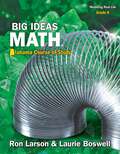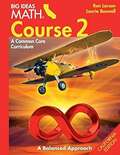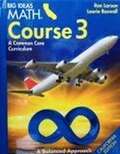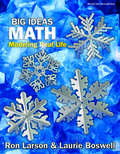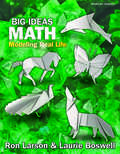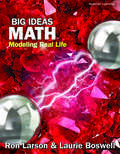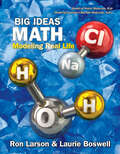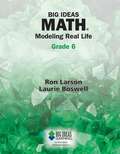- Table View
- List View
Big Ideas Math Alabama 2022 Grade K
by Ron Larson & Laurie BoswellBig Ideas Math Alabama 2022 Grade K
Big Ideas Math Algebra 1, A Common Core Curriculum
by Ron Larson Laurie BoswellBig Ideas Math Algebra 1 is a research-based program providing a rigorous, focused, and coherent curriculum for high school students.
Big Ideas Math Course 1 A Common Core Curriculum, California Edition
by Ron Larson Laurie BoswellBig Ideas Math Course 1 A Common Core Curriculum, California Edition
Big Ideas Math Course 2: A Common Core Curriculum California Student Edition
by Ron Larson Laurie BoswellBig Ideas Math Course 2: A Common Core Curriculum California Student Edition
Big Ideas Math Course 3 A Common Core Curriculum California Pupil Edition
by Ron Larson Laurie BoswellBig Ideas Math Course 3 A Common Core Curriculum California Pupil Edition
Big Ideas Math Green: A Common Core Curriculum
by Ron LarsonBIG IDEAS MATH® Green Common Core Curriculum Ron Larson Laurie Boswell
Big Ideas Math MS Blue: A Common Core Curriculum, Student Edition
by Ron LarsonThe revised Big Ideas Math series uses the same research-based strategy of a balanced approach to instruction that made the first Big Ideas Math series so successful. This approach opens doors to abstract thought, reasoning, and inquiry as students persevere to answer the Essential Questions that introduce each section. The foundation of the program is the Common Core Standards for Mathematical Content and Standards for Mathematical Practice. Students are subtly introduced to "Habits of Mind" that help them internalize concepts for a greater depth of understanding. These habits serve students well not only in mathematics, but across all curricula throughout their academic careers. The Big Ideas Math series exposes students to highly motivating and relevant problems. Woven throughout the series are the depth and rigor students need to prepare for career-readiness and other college-level courses. In addition, the Big Ideas Math series prepares students to meet the challenge of PARCC and Smarter Balanced testing.
Big Ideas Math Modeling Real Life 2021 South Carolina Grade 1
by Ron Larson & Laurie BoswellBig Ideas Math Modeling Real Life 2021 South Carolina Grade 1
Big Ideas Math Modeling Real Life 2021 South Carolina Grade 1
by Ron Larson & Laurie BoswellBig Ideas Math Modeling Real Life 2021 South Carolina Grade 1
Big Ideas Math Modeling Real Life 2021 South Carolina Grade 1
by Ron Larson & Laurie BoswellBig Ideas Math Modeling Real Life 2021 South Carolina Grade 1
Big Ideas Math Modeling Real Life 2021 South Carolina Grade 2
by Ron Larson & Laurie BoswellBig Ideas Math Modeling Real Life 2021 South Carolina Grade 2
Big Ideas Math Modeling Real Life 2021 South Carolina Grade 2
by Ron Larson & Laurie BoswellBig Ideas Math Modeling Real Life 2021 South Carolina Grade 2
Big Ideas Math Modeling Real Life 2021 South Carolina Grade 2
by Ron Larson & Laurie BoswellBig Ideas Math Modeling Real Life 2021 South Carolina Grade 2
Big Ideas Math Modeling Real Life 2021 South Carolina Grade 3
by Ron Larson & Laurie BoswellBig Ideas Math Modeling Real Life 2021 South Carolina Grade 3
Big Ideas Math Modeling Real Life 2021 South Carolina Grade 3
by Ron Larson & Laurie BoswellBig Ideas Math Modeling Real Life 2021 South Carolina Grade 3
Big Ideas Math Modeling Real Life 2021 South Carolina Grade 3
by Ron Larson & Laurie BoswellBig Ideas Math Modeling Real Life 2021 South Carolina Grade 3
Big Ideas Math Modeling Real Life 2021 South Carolina Grade 4
by Ron Larson & Laurie BoswellBig Ideas Math Modeling Real Life 2021 South Carolina Grade 4
Big Ideas Math Modeling Real Life 2021 South Carolina Grade 4
by Ron Larson & Laurie BoswellBig Ideas Math Modeling Real Life 2021 South Carolina Grade 4
Big Ideas Math Modeling Real Life 2021 South Carolina Grade 4
by Ron Larson & Laurie BoswellBig Ideas Math Modeling Real Life 2021 South Carolina Grade 4
Big Ideas Math Modeling Real Life 2021 South Carolina Grade 5
by Ron Larson & Laurie BoswellBig Ideas Math Modeling Real Life 2021 South Carolina Grade 5
Big Ideas Math Modeling Real Life 2021 South Carolina Grade 5
by Ron Larson & Laurie BoswellBig Ideas Math Modeling Real Life 2021 South Carolina Grade 5
Big Ideas Math Modeling Real Life 2021 South Carolina Grade 5
by Ron Larson & Laurie BoswellBig Ideas Math Modeling Real Life 2021 South Carolina Grade 5
Big Ideas Math Modeling Real Life 2021 South Carolina Grade 6
by Ron Larson & Laurie BoswellBig Ideas Math Modeling Real Life 2021 South Carolina Grade 6
Big Ideas Math Modeling Real Life 2021 South Carolina Grade 6
by Ron Larson & Laurie BoswellBig Ideas Math Modeling Real Life 2021 South Carolina Grade 6
